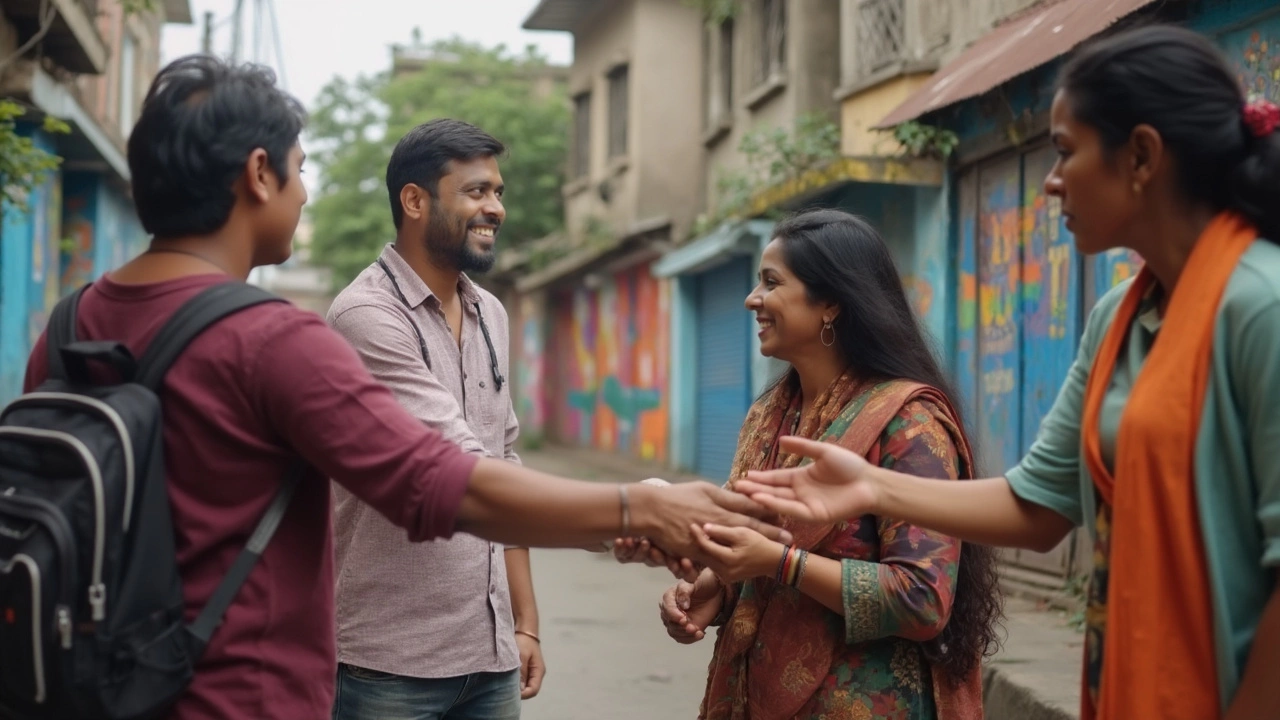Successful Outreach Program: How to Get Real Results in Your Community
 Jun, 3 2025
Jun, 3 2025
Ever notice how some outreach programs just fizzle out after a couple of months? It usually comes down to a missing game plan or connecting with the wrong people. If you want your program to matter, it has to zero in on what the community actually needs—not what you think they need.
Start by getting honest feedback from the people you hope to serve. Skip the guessing game. Knock on doors, send out a short survey, or show up at a local event and ask questions. The fastest way to waste everyone’s time is to build something nobody really asked for.
While you’re collecting input, keep it simple and friendly. Avoid jargon and check your ego at the door. You might be surprised by what you hear—sometimes the smallest changes can make the biggest difference. Remember, your job is to listen more than you talk at this stage.
- Identifying Real Community Needs
- Planning with Purpose and Focus
- Building the Right Outreach Team
- Executing and Connecting with the Community
- Tracking Progress and Adjusting as You Go
Identifying Real Community Needs
If you want your outreach program to have any real impact, you’ve got to get your info straight from the source—the community. Forget trying to eyeball things from the outside. People are pretty good at pointing out what feels off in their neighborhood or what services they actually wish existed.
A smart place to begin is with direct input. According to a 2023 report by the National Council of Nonprofits, 72% of successful outreach projects started with public listening sessions or small focus groups. There’s a reason for that: these formats keep things real and help you avoid building on assumptions.
- Go where people already gather—think churches, little league games, community centers, or barbershops. You’ll get honest feedback when people feel comfortable.
- Don’t just rely on online surveys. About 1 in 4 households still don’t have reliable internet access, especially in rural and underserved communities. Old-school paper surveys or quick chats over coffee work wonders.
- Bring a neighbor or someone from the area with you if you’re an outsider. Folks are way more willing to share openly when they see a familiar face.
After you gather input, it helps to lay out what you’ve learned in an organized way. News flash—people want you to actually do something with what they tell you, not just sit on the info. Use a simple table to track the most common needs mentioned—this will keep things crystal clear when you start planning. Here’s an example from a mid-sized city’s outreach kickoff:
| Community Need | % of Respondents Mentioning | Age Group Most Concerned |
|---|---|---|
| Safe playgrounds | 58% | Parents (25-40) |
| Job training opportunities | 44% | Young adults (18-30) |
| Affordable health clinics | 37% | Seniors (60+) |
By getting this specific, you can set clear priorities—and when you show people real data, it’s easier to build trust. Your outreach isn’t just a nice idea; it’s a direct answer to what folks genuinely care about. Remember, showing up and listening is half the job. What you do with that input is what sets solid outreach apart from the projects that fade away.
Planning with Purpose and Focus
Getting clear on your outreach program's actual goals saves a lot of headaches down the road. Don't just say, "We want to help people"—get specific. For example, do you want to cut food insecurity for single-parent homes by 20% over the next year? Or maybe your goal is to connect 50 job seekers with local employers in three months. The more concrete your goal, the easier it is to plan and measure what works.
About 42% of community projects that fail do so because their goals are too vague or broad (Source: 2023 Nonprofit Leadership Council report). Break your goal down into bite-size, trackable pieces. This keeps your team focused and helps you spot problems early.
- Set SMART goals—Specific, Measurable, Achievable, Relevant, Time-bound.
- Write down the "why" behind your outreach program. Does it fill a gap, respond to a crisis, or build on what’s already there?
- Figure out what resources you actually have, not just what you wish you had—money, people, time, space.
- Map out who your partners are, and who else you need to bring in.
Next, turn your goal into an action plan. Answer questions like: What’s the first step? Who’s doing what? By when? Checking things off as you go keeps everyone on track, and avoids the common "wait... whose job was that again?" problem.
| Task | Responsible Person | Deadline |
|---|---|---|
| Draft survey for feedback | Lisa | June 10 |
| Secure event space | Jorge | June 15 |
| Contact local sponsors | Sam | June 20 |
Staying organized doesn’t have to be fancy. Even a basic table, daily check-ins in a group chat, or a whiteboard in your office can make a big difference. Keep the focus on your outreach program and what you want to change, not just what “sounds nice.” When your planning is dialed in, follow-through gets a whole lot easier.

Building the Right Outreach Team
If you want your outreach program to last, you can't do it all solo. The best teams mix people who care about your community with folks who know how to get things done. Don’t just grab a few volunteers and call it a day. Look for people who bring different skills—organizing, social media, event planning, and maybe even someone who is good with numbers.
Diversity isn’t just a buzzword—real results come from teams that reflect the community they're serving. A 2023 study from the University of Michigan found that outreach programs with team members from different backgrounds were up to 25% more likely to achieve their goals compared to more ‘homogenous’ groups. People listen more when they see themselves in your team.
- Start by outlining what skills you need most. Don’t shy away from being picky; the wrong team can drag the whole thing down.
- Place the word out that you’re seeking help. Use community boards, local Facebook groups, or even ask around at community centers.
- During interviews or chats, ask about both motivation and availability. Someone who is all-in for two weeks then disappears isn’t much help.
- Make roles clear from the get-go—this avoids awkward confusion later.
Small teams often work better for community outreach. According to a 2024 survey by VolunteerMatch, the sweet spot is between 5 and 12 dedicated members. Any bigger gets messy, and you risk losing track of what everyone’s doing. Here’s a quick comparison based on real outreach projects:
| Team Size | Completion Rate | Volunteer Retention |
|---|---|---|
| 3-4 | 62% | 48% |
| 5-12 | 81% | 72% |
| 13+ | 68% | 55% |
Don’t forget about training. Even passionate people need coaching on how to talk to the public, gather feedback, or handle conflicts. A short orientation or an easy-to-follow guide can save a lot of headaches. If everyone’s on the same page, your outreach program has way better odds of making an impact.
Executing and Connecting with the Community
This is where everything happens—ideas meet reality. Once your outreach program is mapped out, it’s all about showing up, being present, and making meaningful connections. You don’t need a fancy office or a huge budget to start; but you do need to be consistent and real with people.
Start by introducing your team to the community. Let folks know who you are and why you’re there. Wear nametags, show up at existing neighborhood events, and don’t hide behind a clipboard. Trust builds faster when faces are familiar and people can put a name to who’s doing the work.
- Organize a kickoff event—nothing big, just something simple like a free coffee morning or a meet-and-greet at a community center. Food always helps break the ice.
- Set up clear ways people can reach you—think WhatsApp groups, simple feedback forms, or even regular office hours at a local park.
- Follow up after first meetings. A thank-you message or a quick call shows you care beyond box-ticking.
Don’t wing it—keep your efforts organized with a shared calendar or even a basic project management tool. This makes sure everyone on your team is on the same page about who’s doing what, when, and where. Programs that skip this step usually find themselves double-booking or missing key opportunities.
Here’s a jaw-dropping stat: According to the Community Tool Box, outreach programs that use local partnerships see engagement rates increase by up to 25% compared to solo efforts. Partnership is a real game-changer.
“Success in outreach depends on trust, visibility, and genuine relationships—not just the program details.” — Maria Hernandez, Director, CityBridge Outreach
A huge mistake? Talking at people instead of listening. Instead, start every event or meeting with an open mic or Q&A. Let the community drive some of the agenda, not just react to it.
| Action | Impact |
|---|---|
| Local partnerships | +25% engagement |
| Regular follow-ups | +30% program retention |
| Consistent events | Higher visibility and trust |
Don’t forget: every meaningful outreach program learns and adapts in real time. If something’s not working, ask why and adjust. Honest face-to-face chats can tell you way more than any spreadsheet. Keep it practical, and people will keep showing up.
Tracking Progress and Adjusting as You Go
If you’re running an outreach program and not tracking anything, you’re basically sailing without a map. Setting up a simple way to check how things are going is a game-changer. You don’t need fancy tools either—a shared spreadsheet or a free project tracker does the trick for most folks.
Figure out what really counts as progress in your outreach. Is it the number of people who show up? The amount of questions you answer? The number of families that sign up for a service? Write those down and check them weekly or monthly. If your big win is boosting turnout, but only two people showed up to your last event, that’s a sign to shake things up.
Want to see what’s working? Here are simple ways to track and adjust:
- Keep a headcount at every event—don’t trust your gut, get the exact number.
- Send out a follow-up survey. Ask if people found value in your program and what they want next time.
- Log simple stories or testimonials. Even a quick sentence can show the real impact behind the numbers.
- Make tracking part of your routine. Set a reminder, delegate the job—just get it done regularly.
If things aren’t working, don’t sweat it. Tweak what you’re doing, and don’t wait a year to make changes. Sometimes just changing the meeting time, the way you promote, or who’s running the show gets better results fast.
Check out this table for some key outreach metrics you could track:
| Metric | What to Look For | Why It Matters |
|---|---|---|
| Event Attendance | Headcounts at each activity | Shows reach and growth |
| Feedback Scores | Survey results post-event | Direct insight into community satisfaction |
| New Sign-Ups | Registrations for your service or program | Indicates engagement |
| Repeat Participation | How many come back? | Shows trust and ongoing interest |
| Volunteer Involvement | Number helping out, hours logged | Keeps program sustainable |
One Stanford study found that outreach projects tracking even just two main results had double the odds of hitting their goals. Bottom line: keep tabs on your progress and stay willing to try something new. That’s how a outreach program goes from surviving to thriving.